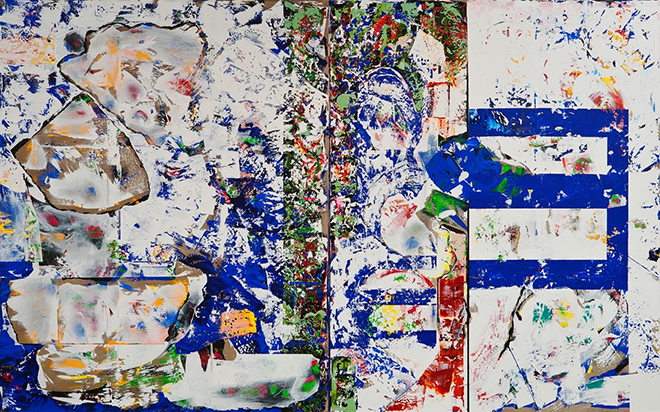
There was a time, over a century ago, when the idea of a purely abstract painting, one which referenced only the means of its creation, was a far-off goal, a seemingly unattainable dream. In the following decades this idea was tested, tried, worked, and re-worked until the project engendered many and various permutations. Post-modern, appropriational, deconstructed -- the list of approaches to this idea is legion; yet there endures some compulsion, some drive that seems hardwired, to create paintings of pure visuality. Just when we think we have come to the end of this story we find new characters waiting in the wings, new gladiators wanting into the arena. In C. Michael Norton’s current exhibit at David&Schweitzer Contemporary we see that this project still has viability. Indeed, Norton seems to open new fields of exploration.
In several of the large-scale works here, Norton has managed to synthesize a wide vocabulary of historical references and combined them with innovations and old-school tinkering to present variations on themes that have seemingly endless variations. A particularly lively one is Things Lost That We Are Not Aware Of (2016). It welds passages of knifed-on, splattered, and scraped paint, which brings together large yellow "gun" shapes that evoke Claes Oldenburg’s "ray guns." Passages of yellow resemble the broken street paint of crosswalks, and taped-off sections look as if pulled out of a late Al Held work. The taped-off sections are particularly suggestive because Norton, like Held, uses various acrylic media that visually "pop" against the rough weave of the linen grounds. There is a searching quality here, and one is left with the feeling that, like de Kooning's Excavation (1950), we see an artist noodling around, combining and rearranging passages of paint according to some internal logic.
Similarly in Einstein’s Edge of Winter (2009 - 2011) we have a diptych, held together with an underlying lattice structure of Yves Klein’s Blue, which seems in the process of either being covered with or obviated by an abraded and scraped white. There is an interesting tension between the strictures of the geometry and the overall randomness of the white. Interspersed and mixed into the white passages are a small spectrum of color, and we are reminded that in the “real” world white is the sum of all color; thus we might choose to see the blue structure as emerging from the void of white, rather than being obliterated by it.
In Stricken (diptych) (2016–2017), which is the strongest work in the show, the unequal panels suggest a topographical map, with the left panel having only the barest traces of brushwork resembling a view of city blocks, buildings, and streets seen from above. The right panel burbles and pops, a volcanic stew of viscous pigment, piled and pulled an inch or two above the surface of the linen. Taken together, the painting at first glance resembles the small maps dropped into newscasts on CNN covering Syrian air strikes.
It is of note that at the moment other artists, such as Rick Briggs, Dona Nelson, and Jackie Saccoccio, are applying some of these same strategies in work which bears superficial comparison; however, Norton largely eschews mark making that is not strictly in the service of the painterly gesture -- no spills, drawn lines, or embedded objects detract from the knife-edge mark. There is a sense of an internal set of rules driving these works, and it is this aspect of Norton’s paintings that seem to tie him to an earlier age. One thinks of color-field painters, or the minimalist structures of Peter Halley, and even to some degree Warhol’s explorations in abstraction in the early '80s. Using linen for a substrate, and contrasting it with the synthetic medium, Norton also hints at bringing this painterly abstraction into the ring with earlier artists, giving a sense of historical weight that, say, Anselm Kiefer did in his painting in the '70s. Standing in front Norton’s paintings, one has the sense that the artist is playing Dr. Frankenstein with the corpus of art history and breathing fresh life into his creatures.
